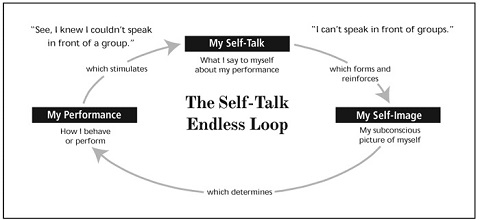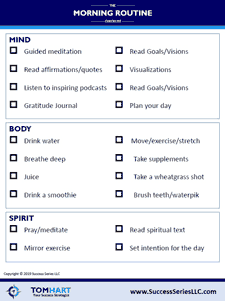#GrowYourLife #BuildYourBusiness
Life Area: Personal
Topic: Negative Self-Talk
5 Ways to Turn Your Negative Self-Talk Into Positive Self-Talk
Whether you tell yourself, “I’m never going to be promoted,” or you constantly think, “People think I’m weird,” negative self-talk affects how you feel and how you behave. In fact, the conversations you have with yourself often turn into a self-fulfilling prophecy.
For example, imagine someone who thinks, “I’m socially awkward and no one wants to talk to me.” To cope with their awkwardness, they avoid striking up conversations with people and limit their interactions. Consequently, people think the person is socially awkward and therefore that belief about themselves is confirmed.
I’m reminded of a story my mentor and friend, Coach John Wooden, told me years ago of a prospective recruit visiting UCLA and telling Coach that he felt the people in Los Angeles weren’t very friendly. To which Coach challenged the young recruit that maybe it was he that was being stand-offish and not being very friendly to those who greeted him.
Negative self-talk and having our own limiting beliefs is a universal problem. Read about how to transcend your limiting beliefs in this guest post [here] and listen to this Talk with Tom podcast episode to learn more. Over the years, I’ve coached countless people on changing their negative dialogue. And I’ve seen first-hand how developing a more productive inner dialogue helps individuals create a more optimistic outlook and create positive change.
So whether you call yourself names or you always talk yourself out of trying something new, here’s how to deal with negative thoughts in a healthy way:
1. Recognize Your Negative Thoughts
When you get an email from the boss that says, “I need to meet with you as soon as possible,” is your first thought that you’re about to be fired or do you think you must be getting a raise?
Many of your thoughts are automatic. They just pop into your head without any conscious effort.
So it’s important to take a second to evaluate your thoughts so you can recognize thoughts that are unrealistic, unproductive, or irrational.
2. Look for Evidence That Your Thought IS True
Just because you think something doesn’t make it true. In fact, most of your thoughts are more likely to be opinions rather than facts.
So ask yourself, “What’s the evidence that this IS true?” Sticking with the example of the email from the boss, what evidence do you have that you’re about to be fired?
Create a list of the evidence that supports your thoughts. Perhaps you called in sick for days in a row recently. Or maybe you missed a deadline on an important project a month earlier. List as many reasons as you can.
3. Look for the Evidence Your Thought IS NOT True
Now, create a list of reasons why your thought might NOT be true. Maybe you are one of the hardest workers on your team and you know that your boss rarely fires people without good reason. Or maybe you’ve been called into meetings with the boss before and you’ve never gotten fired.
If you struggle to find contrary evidence–which is common when your emotions run high–ask yourself, “What would I say to a friend who had this problem?” If your co-worker said, “I’m about to get fired,” you’d likely be able to conjure up some reasons why that might not be true. So give yourself the same consolation you’d give someone else.
4. Reframe Your Thought Into Something More Realistic
Once you’ve looked at the evidence on both sides of the equation, develop a more realistic statement. Telling yourself, “My boss wants to talk to me. There could be many reasons for that email,” can help you keep things in proper perspective.
The goal should be to create a statement based in reality. Be optimistic but realistic.
Don’t try to convince yourself of things that are overly positive–that won’t work either. Instead, the goal should be to create a statement based in reality. Be optimistic but realistic.
5. Ask Yourself How Bad Would It Be If Your Thought Were True
Sometimes, the best way to deal with negative self-talk is to face it head-on. Ask yourself, “How bad would it actually be if I did get fired?” Then, spend a few minutes thinking how you’d respond.
Whether you decided to apply for a different job or you chose to start your own business, you’d have options. It wouldn’t be the end of the world. Reminding yourself that you’d eventually be OK can help take some of the panic, dread, and worry out of the situation.
Just last week I recommended to a client, “Take out a sheet of paper and draw a line vertically down the middle, on the left hand side list the worse-case scenario and on the right the best-case outcome of her particular issue”. After evaluating both sides she concluded that either scenario could actually bring her to a better situation than what she was in. Try that with your next “automatic” negative thinking toward a challenge.
Practice Replacing Negative Self-Talk
You might never get rid of your negative self-talk completely–and that’s fine. The goal is to recognize that your brain’s predictions and conclusions aren’t always accurate. Then, you’ll be less affected by the thoughts that tend to stir up uncomfortable emotions or unproductive behavior.
The more you practice replacing your negative self-talk the more equipped you’ll be to reach your greatest potential. After all, you’ll never become your best self if you’re constantly beating yourself up or dragging yourself down.
A Few More Resources
Check out this YouTube video from my mentor and friend Jack Canfield on Dealing with Negative Self-Talk wherein he gives us the 5 main types of negative thinking:
-
Always or Never Thinking
-
Focusing on the Negative
-
Catastrophic Predicting
-
Mind Reading
-
Guilt Tripping
And study this illustration where Jack depicts the Self-Talk Endless Loop Cycle:

Please share this post with your family and friends.
My mission is to inspire people and organizations to live their highest vision.
I am a Success Strategist and Master Coach. I provide transformational coaching and training for individuals and organizations to help you Grow Your Life and Build Your Business by getting clear and focused on what you want, why you want it, and how to create it. Learn more about me at SuccessSeriesLLC.com.
There is no better endorsement than that of a friend, so if you like what you’re reading or are using my many FREE resources, tell a friend to join the Tom Hart Success Series Community, to receive email notifications of new blog posts and Talk with Tom podcast episodes, learn of upcoming events, and other news, by visiting my website and clicking on the offer to receive my FREE monthly resource by leaving their email address OR forward this to them and have them simply click here (we respect your privacy and do not tolerate spam and will never sell, rent, lease or give away your information to any third party).



